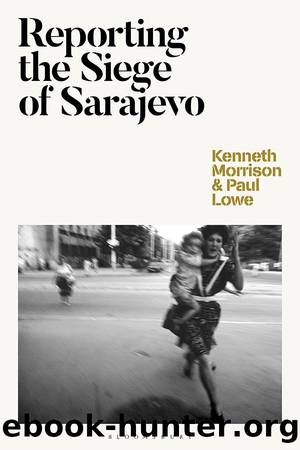Reporting the Siege of Sarajevo by Kenneth Morrison & Paul Lowe

Author:Kenneth Morrison & Paul Lowe [Morrison, Kenneth & Lowe, Paul]
Language: eng
Format: epub
Tags: History, Military, General, Europe, Eastern, Modern, 20th Century, Language Arts & Disciplines, Journalism, Photography, Photojournalism, Literary Collections
ISBN: 9781350081789
Google: nS8LEAAAQBAJ
Goodreads: 53265598
Publisher: Bloomsbury Academic
Published: 2021-01-14T01:49:13+00:00
5
Reporting daily life
As the siege relentlessly continued, a daily routine of reporting became increasingly established. Many of the TV and radio reporters and crews and the photographers working for the wire services were often based in Sarajevo for one or two months at a time. This core group rotated frequently in and out of the city, building up a network of contacts and the experience of the layout of the city that helped to keep them safe and gave them access to politicians and, to a lesser extent, the ARBiH. Yet, the daily rhythm of reporting was quite unlike that to which they had become so accustomed. According to Christiane Amanpour:
The experience of reporting from Sarajevo was very different from reporting today, where you have all of the demands of 24-hour live news. We worked constantly from early morning to sundown and spent most of the time gathering and telling stories â and, in the case of Sarajevo, many of these were human stories. We would go to hospitals, schools, talk to women, children and tell their stories of survival. This is why, I believe, the reporting from within the besieged city of Sarajevo was so powerful and effective.1
While 24-hour news was emerging â CNN was a rare exception at the time â even for those who worked for those channels that operated around the clock, the rhythm of the day became quite well established and, for some, rather pedestrian. The BBC Radio journalist Martin Dawes recalled how he was, âAway for six months a year for the whole of 1993. That was basically doing Central Bosnia or Sarajevo, normally three weeks, sometimes four weeks at a time.â2 For these reporters, daily life often followed a relatively predictable routine. Indeed, one of the notable features of the siege was that outside the periods of very heaving shelling and fighting, the city could be eerily still, with little to report. The AP photographer Enric Marti recalled that âthe front lines were very stable, there was not too much shooting ⦠for the ones that were actually living there like I did there were periods, they were long periods actually where there was not much happeningâ.3 At such times, Sarajevo would fall off the news agenda of the editors back in the journalistsâ respective countries. Even during periods of heavy fighting the story of Sarajevo was often a hard sell and entirely dependent on what might be happening domestically. As Gigi Riva noted, he found it harder to convince his editors to publish pieces on Sarajevo â and Bosnia and Herzegovina more generally. âThe Bosnian warâ, he said, âwas considered a second-tier conflict in Italy and, above all it just didnât sell newspapers.â4 So, during these periods, the working lives of many journalists followed a predictable formula. Dawes explains the morning ritual for the BBC Radio team:
If it was routine, fairly routine, you would get up, talk to your translator and ask what was on radio Bosnia if theyâd been listening, that was the first thing.
Download
This site does not store any files on its server. We only index and link to content provided by other sites. Please contact the content providers to delete copyright contents if any and email us, we'll remove relevant links or contents immediately.
Kathy Andrews Collection by Kathy Andrews(11730)
The remains of the day by Kazuo Ishiguro(8823)
Paper Towns by Green John(5091)
Spare by Prince Harry The Duke of Sussex(5072)
Industrial Automation from Scratch: A hands-on guide to using sensors, actuators, PLCs, HMIs, and SCADA to automate industrial processes by Olushola Akande(4983)
The Body: A Guide for Occupants by Bill Bryson(4974)
Machine Learning at Scale with H2O by Gregory Keys | David Whiting(4183)
Be in a Treehouse by Pete Nelson(3948)
Never by Ken Follett(3793)
Harry Potter and the Goblet Of Fire by J.K. Rowling(3775)
Goodbye Paradise(3728)
Into Thin Air by Jon Krakauer(3313)
The Remains of the Day by Kazuo Ishiguro(3294)
The Cellar by Natasha Preston(3262)
The Genius of Japanese Carpentry by Azby Brown(3226)
Fairy Tale by Stephen King(3220)
120 Days of Sodom by Marquis de Sade(3182)
The Man Who Died Twice by Richard Osman(2997)
Drawing Shortcuts: Developing Quick Drawing Skills Using Today's Technology by Leggitt Jim(2996)
